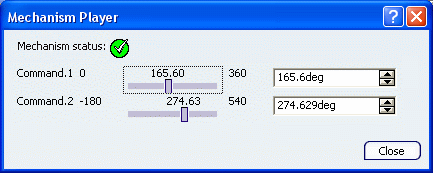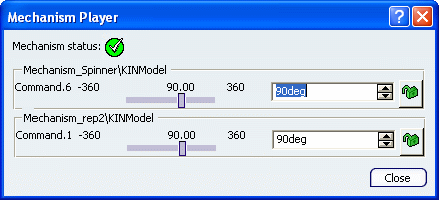
Animate Using the Mechanism Player
The Mechanism player provides direct control over the values that are assigned to commands in the mechanism.
It also allows you to control multiple commands simultaneously.
Optional: Click
 to update the mechanism and all of its references.
to update the mechanism and all of its references. Select the mechanism to be reviewed in the specification
tree.
Click Mechanism Player . .
The Mechanism Player appears:

If an incident is detected during the animation, a message appears. You can access the immersive Incident Diagnosis dialog box by clicking  to analyze and solve the problem. See Diagnosing Computation Incidents. to analyze and solve the problem. See Diagnosing Computation Incidents.
A slider and value box are displayed for each command in
the mechanism. The commands that are specified in assembled mechanisms are grouped in dedicated frames.

If multiple commands are linked in the mechanism,
adjusting the value for one command will update the linked commands
automatically.
Assign a value to a command using one of the following
techniques:
- Drag the slider.
- Type a value directly in the value box.
- Use the arrows to step through values or select values
directly.
Right-click on the value box and select from the menu
that appears to adjust the following settings:
- Change step: Modify the value incrementation
that is applied when you click the arrows in the value box;
the default incrementation is 1.
- Previous values: Select from a list of previously
applied command values.
- Range: Edit the upper and lower limits for
the command value; this option is available only if limits
have not been defined on the engineering connection (see
About Limits for more information).
When you are done reviewing the mechanism, click
Close.

Animate with an Active Review Using the Mechanism Player
The Mechanism player used conjointly with an active review provides the capability to capture and store multiple configurations of a mechanism and also create slides with annotations.
You can use the active review instanced underneath a product or under a validation of a product that contains a mechanism.
Activate a review. See VPM Digital Review User's Guide:Creating a Review. Click Mechanism Player . . Assign a value to a command using one of the following
techniques:
- Drag the slider.
- Type a value directly in the value box.
- Use the arrows to step through values or select values
directly.
When you are done reviewing the mechanism, click
Close.
The final mechanism positions (mechanism's transient position and command values) are stored in the Review object. Repeat Step 2 to animate your mechanism with the same active review. The animation is intialized with the overloaded mechanism's positions stored in the review (the mechanism's transient position and command values that were calculated during the last animation). When you are done reviewing the mechanism, click
Close.
|
![]()
![]()

